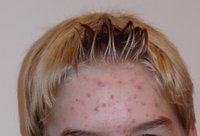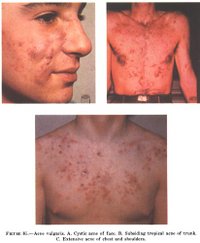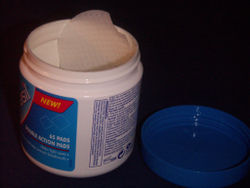Acne
Acne is an inflammatory disease of the skin, caused by changes in the pilosebaceous units (skin structures consisting of a hair follicle and its associated sebaceous gland). Acne lesions are commonly referred to as pimples or zits. more...
The condition is common in puberty as a result of an abnormal response to normal levels of the male hormone testosterone. The response for most people diminishes over time and acne thus tends to disappear, or at least decrease, after one reaches their early twenties. There is, however, no way to predict how long it will take for it to disappear entirely, and some individuals will continue to suffer from acne decades later, into their thirties and forties and even beyond. Acne affects a large percentage of humans at some stage in life.
The term acne comes from a corruption of the Greek άκμή (acme in the sense of a skin eruption) in the writings of Aëtius Amidenus.
Symptoms
The most common form of acne is known as "acne vulgaris", meaning "common acne." Excessive secretion of oils from the glands combines with naturally occurring dead skin cells to block the hair follicles. Oil secretions build up beneath the blocked pore, providing a perfect environment for the skin bacteria Propionibacterium acnes to multiply uncontrolled. In response, the skin inflames, producing the visible lesion. The face, chest, back, shoulders and upper arms are especially affected.
The typical acne lesions are: comedones, papules, pustules, nodules and inflammatory cysts. These are the more inflamed form of pus-filled or reddish bumps, even boil-like tender swellings. Non-inflamed 'sebaceous cysts', more properly called epidermoid cysts, occur either in association with acne or alone but are not a constant feature. After resolution of acne lesions, prominent unsightly scars may remain.
Aside from scarring, its main effects are psychological, such as reduced self-esteem and depression. Acne usually appears during adolescence, when people already tend to be most socially insecure.
Causes of acne
Exactly why some people get acne and some do not is not fully known. It is known to be partly hereditary. Several factors are known to be linked to acne:
- Hormonal activity, such as menstrual cycles
- Stress, through increased output of hormones from the adrenal (stress) glands
- Hyperactive sebaceous glands, secondary to the three hormone sources above
- Accumulation of dead skin cells
- Bacteria in the pores, to which the body becomes 'allergic'
- Skin irritation or scratching of any sort will activate inflammation
- Use of anabolic steroids
- Any medication containing halogens (iodides, chlorides, bromides), lithium, barbiturates, or androgens
- Exposure to high levels of chlorine compounds, particularly chlorinated dioxins, can cause severe, long-lasting acne, known as Chloracne
Traditionally, attention has focused mostly on hormone-driven over-production of sebum as the main contributing factor of acne. More recently, more attention has been given to narrowing of the follicle channel as a second main contributing factor. Abnormal shedding of the cells lining the follicle, abnormal cell binding ("hyperkeratinization") within the follicle, and water retention in the skin (swelling the skin and so pressing the follicles shut) have all been put forward as mechanisms involved.
Read more at Wikipedia.org




